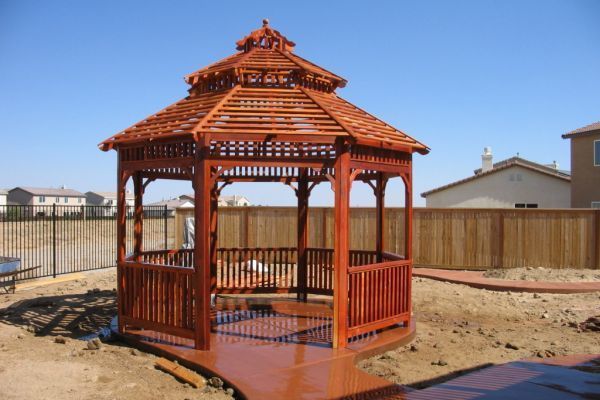Octagonal Gazebo Blueprints
Hexagon Pergola Creation Drafts - Few Successful Solutions To Construct A Gazebo Effortlessly

Diy pavilion plans The next step of the diy pavilion project is to install the shade elements. Once your main beams are set in place you are now ready to fix your cross beams. The larger the load, the more gunpowder it contains. Brace with a 2x4 by nailing one end to the support and securing the free end with a stake driven into the ground. If you want to see more outdoor projects, we recommend you to check out the rest of the free plans. For this particular project, the acrylic sheets are 60cm (https://www.squaregazeboplans.com/summerhouse-plans) wide, you might have to adjust the spacing between battens accordingly to your project.
To do this, hold the joist up between the two beams, and set a 2x4 flat against the post and beam transfer the line with a pencil. Fit the braces to the frame of the pavilion, as shown in the diagram. Base anchors would take less time to add but your terrain and position should be the deciding factors rather than time spent on the project. This is the most time-consuming, but most satisfying part of the project. If there are permits to be obtained, a professional will know how to go about, and it could save a lot of hassle.
In this example, the back wall is 96 inches and the front wall is 82 inches-any shorter and your guests may hit their heads on the gutter. You'll have to rent a plate (additional hints) compactor. This will create enough room for the support beams to be fully implanted into the ground. By this stage you should already have fitted your newel posts, which are an integral part of your balustrading. Snap a chalk line across the rafters where the blocking will go, and then work your way across the joists, measuring and notating the lengths of blocking you'll need. Originating from the Victorian era, gazebos, with their post-and-beam construction, still retain numerous elements of Victorian-era design.
Procesando video...
Install the front and rear struts first, fastening them to the face of the support columns above the girder. However, these kits are relatively easy to install and affordable. The solution was in a neglected corner of their backyard-the perfect spot for an outdoor living room based on a simple platform deck. If you're looking for a different deck, check out all of our free deck plans here. Start with the table-top board closest to the inside, and line it up with the edge of the inside posts. How you design the house is up to you. Remove leaves, twigs and other debris from the gazebo's roof every two months.
Spread that end of the curtain as far as it can go, as if closing the curtain. We will discuss the various materials further in this guide. You would need a big drill bit and a powerful drill for this step. Any movement happens so slowly that it's hard to detect. Screw pairs of temporary braces to stakes in the ground and clamp the braces to the columns to keep them vertical in both directions for the remainder of the project. Then, you'll build the deck, up off the ground, between the frame pieces. It would provide you with the perfect spot for relaxing and entertaining during the warmer season.
Otherwise you'll have to regrade or build a retaining wall. If it's square and true the lines would connect. Rinse the wheelbarrow and hoe immediately after using to keep remnants from permanently setting. The manufacturer's chart tells you how many of each shape to put into each ring. You can use your own timber or purchase hardwood flooring and use a floor nailer to add it to your summerhouse. Determining the location for the pavilion is essential, as you have to comply with the local building codes. The gravel also eased dialing in the template's final position. Begin the gazebo-building project by putting up the wall posts.
Apply a polyurethane spray, if desired, annually to a wrought-iron gazebo. A pergola is a beautiful addition to a backyard. If you're considering doing everything from reading to playing to working in a single space, rethink the number of spaces you need. Here is where you will need extra hands and your column level and regular levels. Remove the excess materials with a chisel and then smooth the recess with sandpaper. As you wisely pointed out, easier is not always the best way to go, and with a structure that big, you definitely want it to be safe.